Egyptian Pyramids
Of the seven ancient wonders of the world, today only one stands basically intact. Yet this is also the oldest structure of the wonders. It is the Great Pyramid of Giza of Egypt built around 2570 BCE. The Great Pyramid was the tallest man-made structure in the world for more than 3,800 years until the nineteenth century CE. Recently, researchers have noticed that ancient Egyptians had the ability to align structures to true north very precisely, and some of the pyramids were aligned to within one-tenth of a degree. True north is also called the "geodetic north" or "geographic north." It is the actual location of the north pole, which is not the same as the magnetic north pointed to by a compass. How the ancient Egyptians were able to locate the true north is still a puzzle.
Egyptian pyramids originated from simple rectangular "mastaba" tombs that were being constructed in Egypt over 5,000 years ago. A mastaba tomb is a rectangular burial mound with sloping walls and a flat roof, usually made of mud. A major advance occurred during the reign of the pharaoh Djoser of the 3rd Dynasty during the Old Kingdom. Around 2670 BCE, Djoser's architect, Imhotep, built a pyramid by placing six mastabas, each smaller than the one beneath, in a stack to form a pyramid rising in steps. This “step pyramid” stands on the west bank of the Nile River at Sakkara near Memphis. It was considered to be the earliest large-scale cut stone construction made by man. Like later pyramids, it contains various rooms and passages, including the burial chamber of the king. Below is a picture of Djoser’s step pyramid:
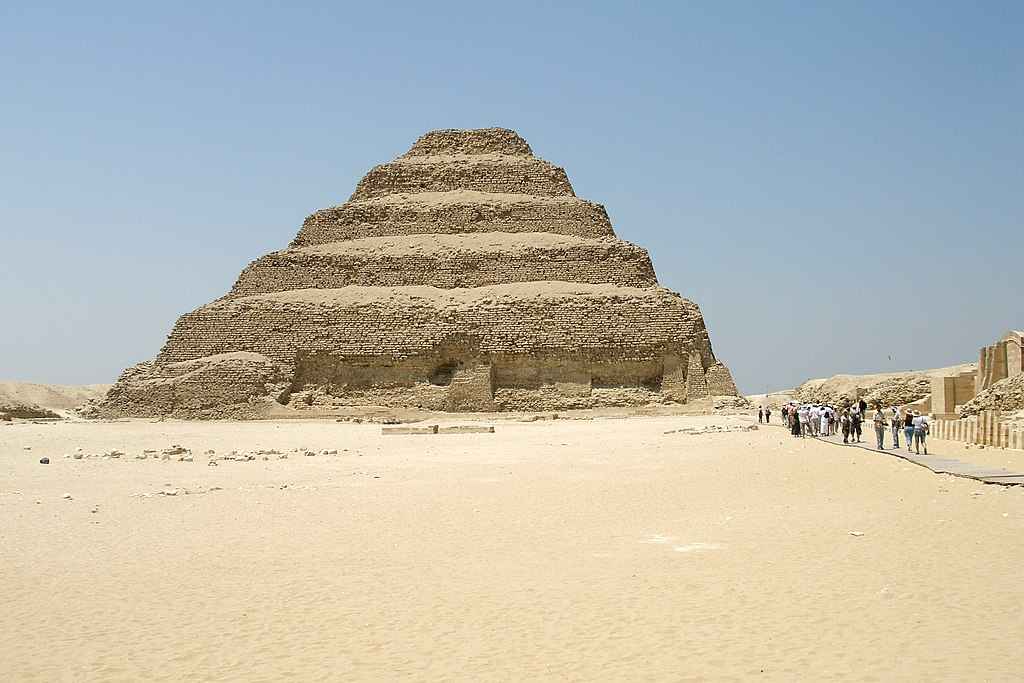
The next development is the “bent” pyramid. The Bent Pyramid is an ancient Egyptian pyramid located at the royal necropolis of Dahshur, approximately 40 kilometers south of Cairo, built under the Old Kingdom Pharaoh Sneferu (around 2600 BC). Below is a picture of the Bent Pyramid:
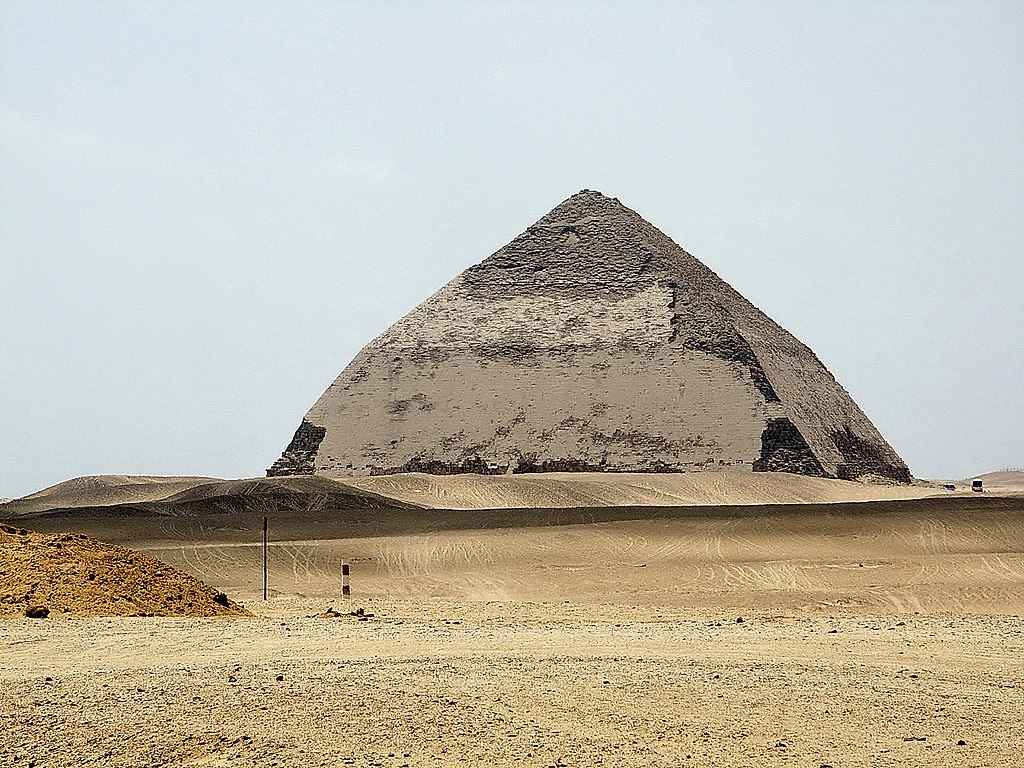
The lower courses of the pyramid were built at an angle of 54 to 55 degrees, but the upper courses were built at a lower angle of 43 degrees, giving it the unique shape which has led to its modern name. It is also unique among the approximately ninety pyramids to be found in Egypt, in that its original polished limestone outer casing remains largely intact. British structural engineer Peter James attributes this to larger clearances between the parts of the casing than used in later pyramids; these imperfections would work as expansion joints and prevent the successive destruction of the outer casing by thermal expansion. When it was constructed it was called “Sneferu is shining in the south” (or “Sneferu is shining”) because it was clad in polished Tura limestone. Below is the name in ancient Egyptian writing:

As discussed in the Egyptian writing page on hieroglyphic writing, the left portion of the hieroglyphic is a cartouche, which means that the name inside is a royal name. It is the name of Sneferu. The meaning of the writing is "Sneferu Shines."
Archaeologists now believe that the Bent Pyramid represents a transitional form between step-sided and smooth-sided pyramids. It has been suggested that due to the steepness of the original angle of inclination the structure may have begun to show signs of instability during construction, forcing the builders to adopt a shallower angle to avert the structure's collapse. This theory appears to be borne out by the fact that the adjacent Red Pyramid (about 1 kilometer to the north), built immediately afterwards by the same pharaoh, was constructed at an angle of 43 degrees from its base. The Red Pyramid is believed to be Egypt's first successful attempt at constructing a "true" smooth-sided pyramid. Below is a picture of the Red Pyramid:
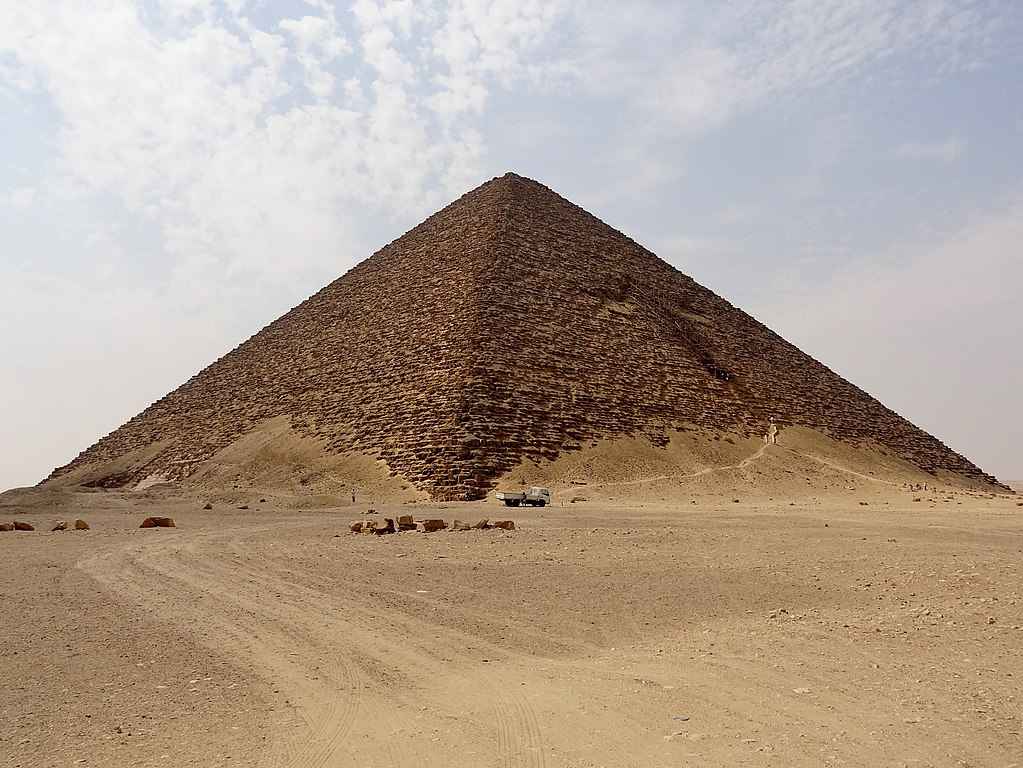
Snefru’s son Khufu (reign around 2589 BCE) continued pyramid building. The first, and largest, pyramid at Giza was built by the Khufu. His pyramid, which today stands 455 feet (138 meters) tall, is known as the "Great Pyramid." Initially standing at 481 feet, the Great Pyramid was the tallest man-made structure in the world for more than 3,800 years until the nineteenth century CE. Over time, most of the smooth white limestone casing was removed, which lowered the pyramid's height to the present 455 ft. What is seen today is the underlying core structure. The base was measured to be about 755.6 ft. square, giving a volume of roughly 92 million cubic feet). The Great Pyramid was built by quarrying an estimated 2.3 million large blocks weighing 6 million tons in total. Primarily local limestone from the Giza Plateau was used. Other blocks were imported by boat down the Nile: White limestone from Tura for the casing, and granite blocks from Aswan, weighing up to 80 tons, for the King's Chamber structure. Below is a picture of the Great Pyramid:
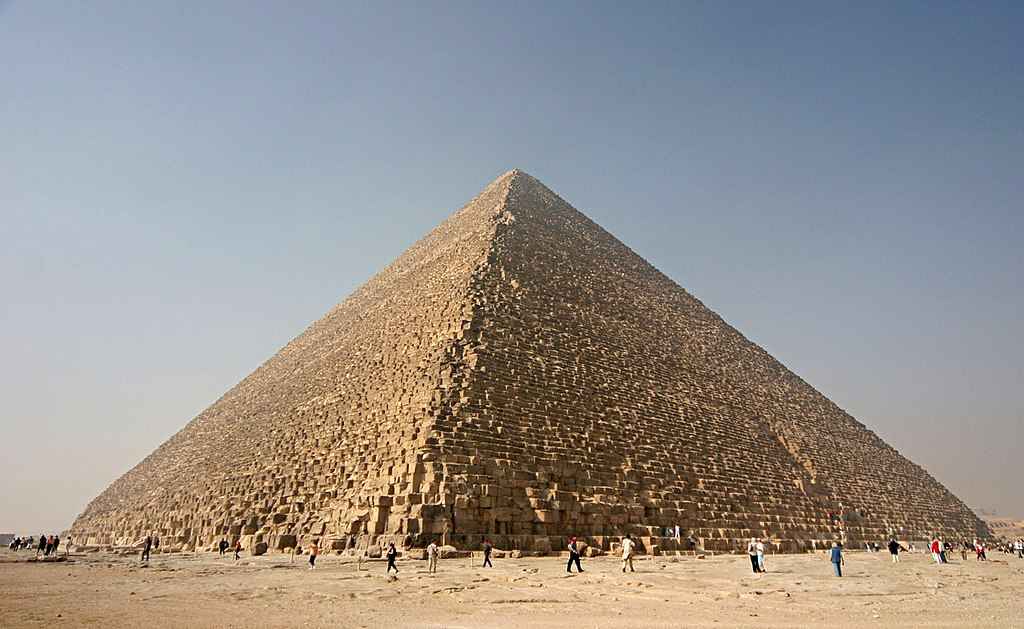
Below is the Egyptian name of the pyramid in ancient Egyptian writing (its ancient Egyptian name was Akhet, which can be translated as “Where the sun rises and sets”, “Horizon” or even “Place of coming into being”):

Below is Khufu's Egyptian name enclosed in a cartouche:
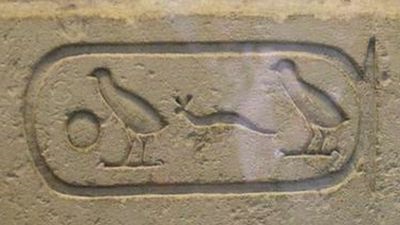
Khufu’s son Khafre (reign around 2570 BE) also built pyramid. The pyramid of Khafre was only slightly smaller than Khufu's but stood on higher ground. It is the second-largest pyramid at Giza. There is a sphinx near Khafre’s pyramid (a sphinx is a creature with the body of an animal, such as lion, and the head of a human). Many scholars believe that the Sphinx monument was built by Khafre, and that the face of the Sphinx was modeled after him. The Great Sphinx of Giza is a giant limestone statue measuring 240 feet (73 meters) long and 66 feet (20 meters) high. It is one of the world’s largest monuments. Below is a picture of the Great Sphinx:
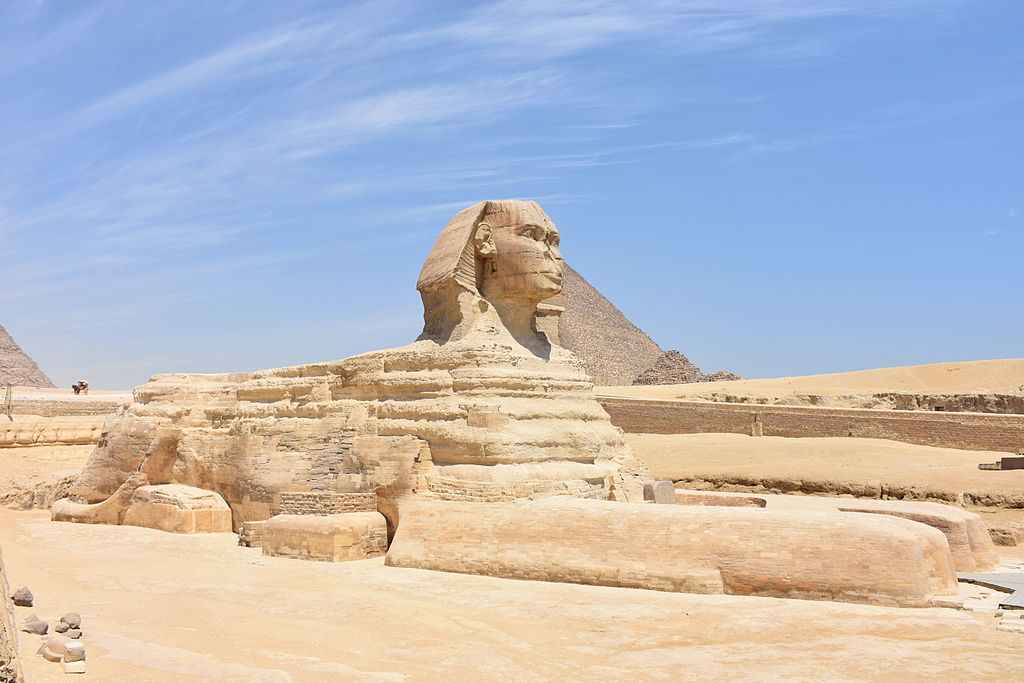
The third pharaoh to build a pyramid at Giza was Menkaure (reign started around 2530 BCE), who opted for a smaller pyramid that stood 215 feet high.
Pyramid building was at its height from the Fourth through the Sixth Dynasties. Smaller pyramids continued to be built for more than one thousand years. Scores of them have been discovered, but the remains of others are probably still buried under the sand. The most important pyramid complexes are at Saqqara, Meidum, Dahshur and Giza. Some pyramids are only mud-brick remnants now.
Pharaohs gradually stopped building pyramids during the New Kingdom (1550-1070 BCE), choosing instead to be buried in the Valley of the Kings, which is located about 300 miles (483 km) south of Giza.
How were the pyramids built?
No cameras were around thousands of years ago when the ancient Egyptians built the three pyramids of Giza for each of three pharaohs Khufu, Khafre and Menkaure. So, scientists have had to piece together clues as to how these towering monuments were constructed. Over the past few decades, a series of new discoveries and studies allowed researchers to paint a clearer picture of those feats. Yet, there are still lots of unknowns.
The pyramids were built using a planning process that is not unlike modern projects. It should be noted that pyramid building required constructing not just the pyramids, but also the temples, boat pits and cemeteries located near the enormous structures. A large work force needed to be maintained for many years. Thus, sophisticated planning would have been involved.
In 2010, a team of archaeologists discovered papyri, called The Diary of Merer (also known as Papyrus Jarf), dating to the reign of Khufu at the site of Wadi al-Jarf on the Red Sea. They are the oldest known papyri with text, dating to the 27th year of the reign of Khufu. The Diary (written with hieroglyphs) mostly consists of lists of the daily activities of Merer, a middle ranking official with the title inspector, and his crew. Very similar to modern-day ledgers, the ancient financial balance sheets record revenues transferred from various Egyptian provinces in red and payments for food and wages in black. It includes logbooks that document the transportation of white limestone blocks from the Tura quarries (near modern-day Cairo) to Giza -- the blocks were shipped to Giza by boat along the Nile River and a series of canals. One boat trip took four days, the papyri said. A translation of part of the papyri is provided below.
The pharaohs appointed a high-ranking official to oversee pyramid construction. The Diary wrote that the pharaoh's half-brother, Ankhaf, was the vizier (highest official to serve the king in ancient Egypt) and "chief for all the works of the king."
Many of the stones used in Khufu's pyramid are from a horseshoe-shaped quarry located just south of the pyramid. Construction workers would have used blocks from a quarry located south-southeast of Menkaure's pyramid to build that pyramid. However, it is unclear which quarry was used for Khafre's pyramid.
When nearly complete, each of the Giza pyramids was furnished with a smooth outer casing made of limestone. Little of this outer casing remains today, having been reused for other building projects in Egypt over the millennia.
To move the stones overland, the Egyptians would have used large sledges that could be pushed or pulled by gangs of workers. The sand in front of the sledge was likely dampened with water, something that reduced friction, making it easier to move the sledge. Scientists who studied pyramid construction noticed that ancient Egyptian artwork showed water being poured in front of sledges. Below is a famous decoration inside the tomb of King Djehutihotep that represents the transport of a colossal statue of him that was nearly 22.3 ft high, being transported by 172 workers using ropes and a slide, in an effort that is facilitated by pouring water in front of the slide.
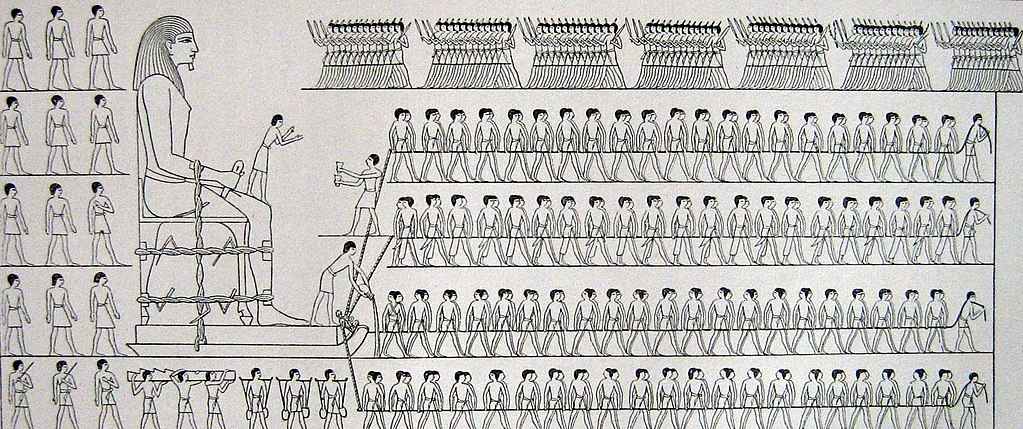
A team of physicists from the University of Amsterdam did a calculation and published the results in 2014 in the journal Physical Review Letters. It turns out that wetting Egyptian desert sand can reduce the friction by quite a bit. They estimated that Egyptians needed only half of the people to pull a sledge on wet sand, compared to dry sand.
Most Egyptologists agree that when the stones arrived at the pyramids, a system of ramps was used to haul the stones up. However, Egyptologists are uncertain how these ramps were designed. Little evidence of the ramps survives, but several hypothetical designs have been proposed over the last few decades.
Recently, a team of researcher proposed that ancient Egyptians used hydraulic elevation mechanism to raise the stones. This is their paper:
On the possible use of hydraulic force to assist with building the step pyramid of saqqara
Estimates given by various archaeologists for the size of the workforce at Giza tend to hover around 10,000 people for all three pyramids. These people were well-fed -- enough cattle, sheep and goats were slaughtered every day to produce 4,000 pounds of meat, on average, to feed the pyramid builders. Animals were brought in from sites on the Nile Delta and kept in a corral until they were slaughtered and fed to the workers. The workers' meat-rich diet may have been an inducement for people to work on the pyramids.
In addition to workers, artists were employed to decorate the interior of the pyramids. Writings (hieroglyphic texts) were inscribed on walls of the pyramids. After hieroglyphic language was deciphered, the writings (called pyramid texts) provided important information about life and social structure of ancient Egyptian society.
As mentioned in the beginning of the page, ancient Egyptians were able to point the pyramids to the true north. How did they do it? There are many theories. For example, in 2013 Glen Dash published an article on this issue. He wrote: "The Egyptians most likely used a circumpolar star to align the descending passageways of the Bent, Red, Great, and Khafre Pyramids with due north." (Note: A circumpolar star is a star that, as viewed from a given latitude on Earth, never sets below the horizon due to its apparent proximity to one of the celestial poles. Circumpolar stars are therefore visible from such location toward the nearest pole for the entire night on every night of the year). He speculated that the Egyptians used the star Thuban, the pole star of their time (in the present day the star Thuban is located in the constellation Draco). In 2015, he proposed a different method: the "quinoctial solar gnomon method." However, none of the theories can provide a satisfactorily explanation.
Below are some documents related to the pyramids:
(1) Sustainability problems of the Giza pyramids
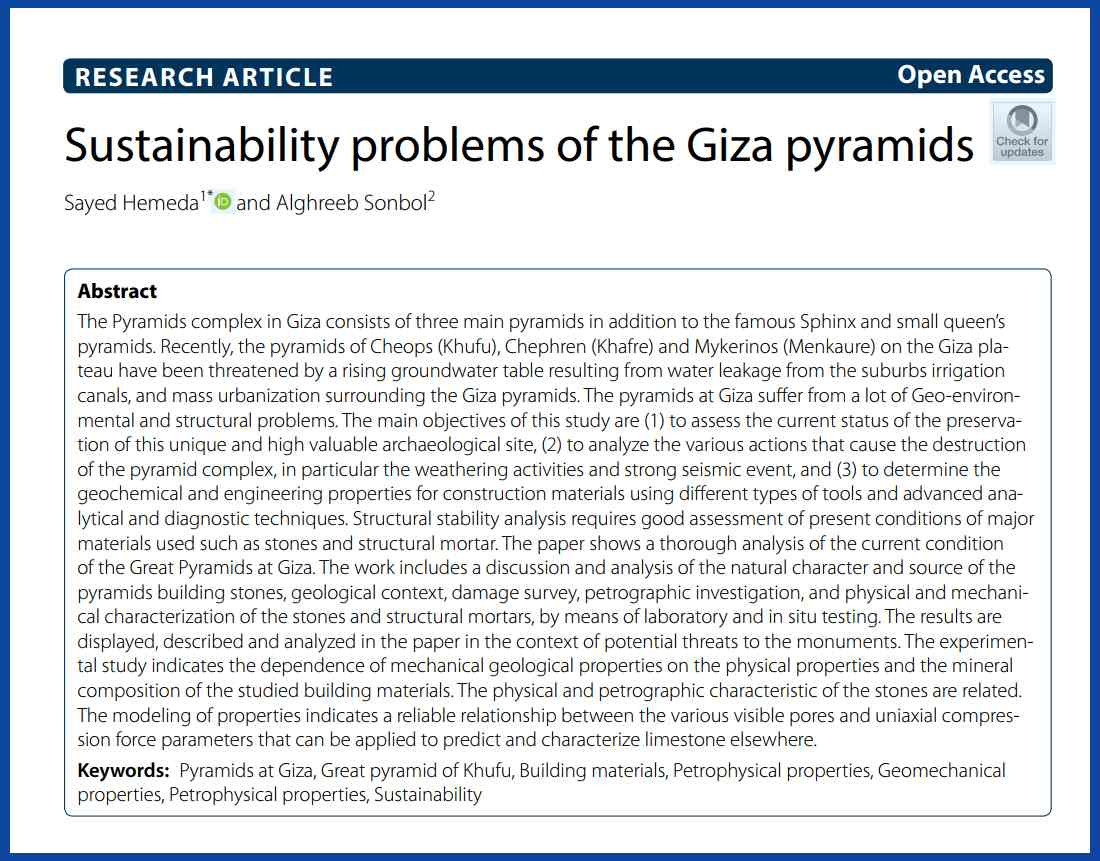
(2) The Complete Pyramid -- Solving the Ancient Mysteries
Beginning to page 58 (file size: about 25 MB)
Pages 59-121 (file size: about 25 MB)
Pages 122-191 (file size: about 32 MB)
Pages 192 to end (file size: about 32 MB)

(3) The Organization of the Pyramid Texts
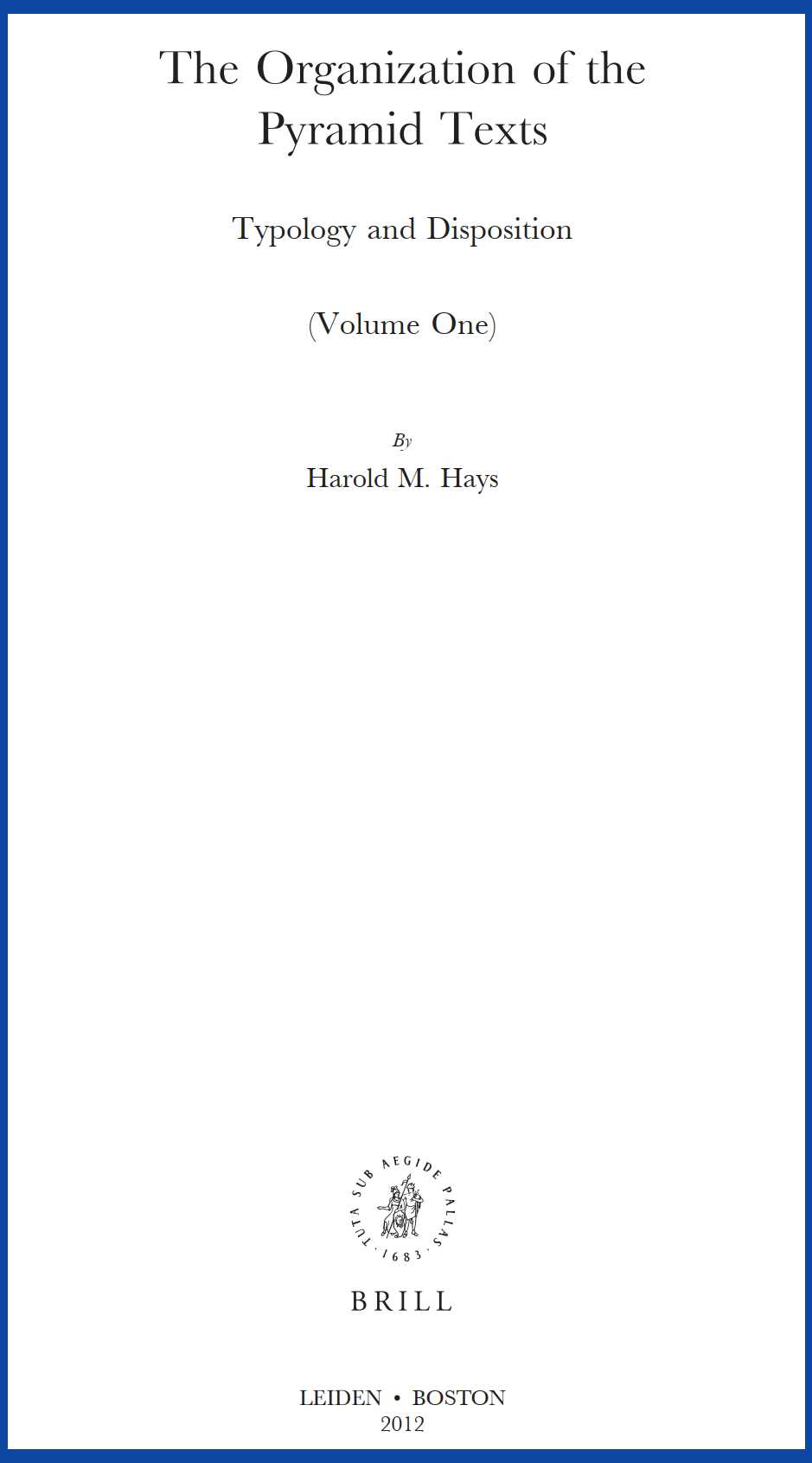
(4) Les Papyrus De La Mer Rouge I -- Le « Journal De Merer »
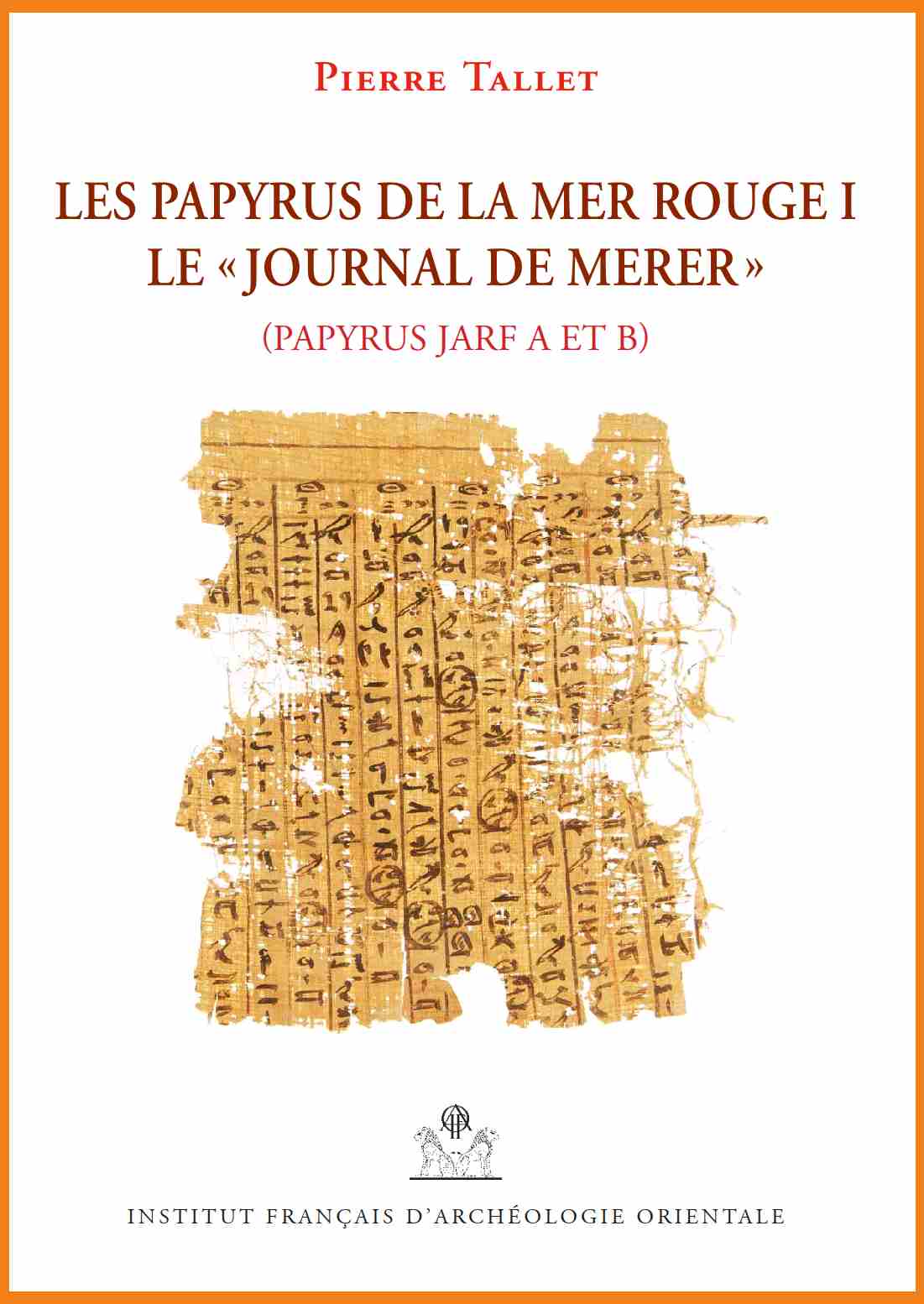
.